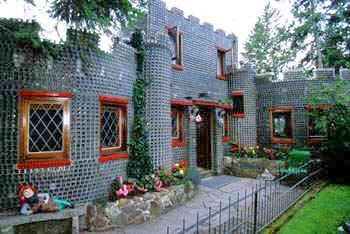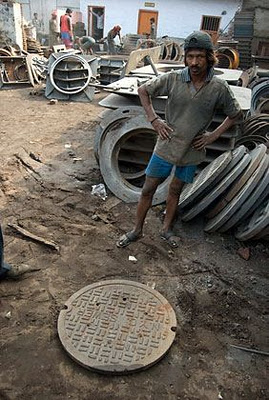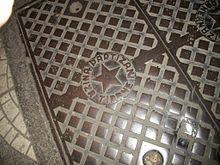The Bottled house in Boswell

The Bottled house in Boswell, Canada, is an extraordinary roadside attraction. The house was built from more than half a million useless enclosing fluid bottles. The over 500,000 square-shaped bottles weighed over 250 tons (Darby2, 2006). The house, built by David H. Brown in 1952, is a three-dimensional work of art. The foundation of the bottled house was set upon a solid rock. The whole house takes a cloverleaf pattern, while the three main rooms take a circular shape.
The bottles are generally stuck together using mortar. The windows contain a wire mesh for “security” reasons. The color of the walls of the house is light blue; the area surrounding the windows is colored brown and red, while the floor is light purple. The bottles were arranged in such a manner that the walls appeared like small bricks of rectangular shape on the outside. This arrangement appeared rough from far, but when touched, it was as smooth as fur. The colors and lines used by Mr. Brown are well balanced, with no singular color being more conspicuous than the other.
The subject matter depicted by this artwork relates to the use of “useless” materials in our environment. As a result, the artwork is representational. It represents the employment of some materials that are discarded to make important items. Mr. Brown was trying to encourage people to indulge their whims to do peculiar things with discarded materials. The house is used as an attraction site, a habitat, and for aesthetic purposes. The role that this work of art exemplifies is showing the human race a New Way. Mr. Brown saw similar things as his colleagues but interpreted them in an inventive manner. As a result, this would help other people observe the earth in new ways. A final point of caution goes to those people who live in glass or bottled houses; never throw stones!
Manhole covers
The second type of artwork is the manhole covers. This type of artwork also offers magnificent features to look at. They are usually three-dimensional works of art. Manhole covers are made from cast iron and sometimes have concrete infill. Regularly, manhole covers are made using sand casting procedures (Timmons & Huggins, 2007). This type of artwork does not depict any subject matter apart from showing its aesthetic value. The colors used vary depending on the place of application.


Depending on the place of application, manhole covers use different types of lines to depict different textures. Also, they come in different shapes; however, the most prevalent shape is circular. This kind of artwork is non-objective. This is attributed to the fact that it takes nothing from actuality. As stated earlier, this art form is purely created for aesthetic purposes. As such, this kind of art intends to utilize the components and rules of art in such a manner that would be visually stimulating. It is purely that simple. The artwork has no symbolic meaning.
There are four traditional roles of the artist that are exemplified; maintaining historical records; giving structure to the indefinable; exposing the hidden, and explaining the world in a new manner. The images or shapes or figures depicted on the manhole covers could depict any one of these roles. The artist can interpret things, record history visually shows emotions, and reveal truths in an inventive manner.
References
Darby2. The Bottle house of Boswell. (n.d). Web.
Making of Manhole covers. (n.d.). Web.
Manhole cover. (n.d). Web.
Timmons, H., and Huggins, J. A. (2007). New York Manhole Covers, Forged Barefoot in India. The New York Times. Web.